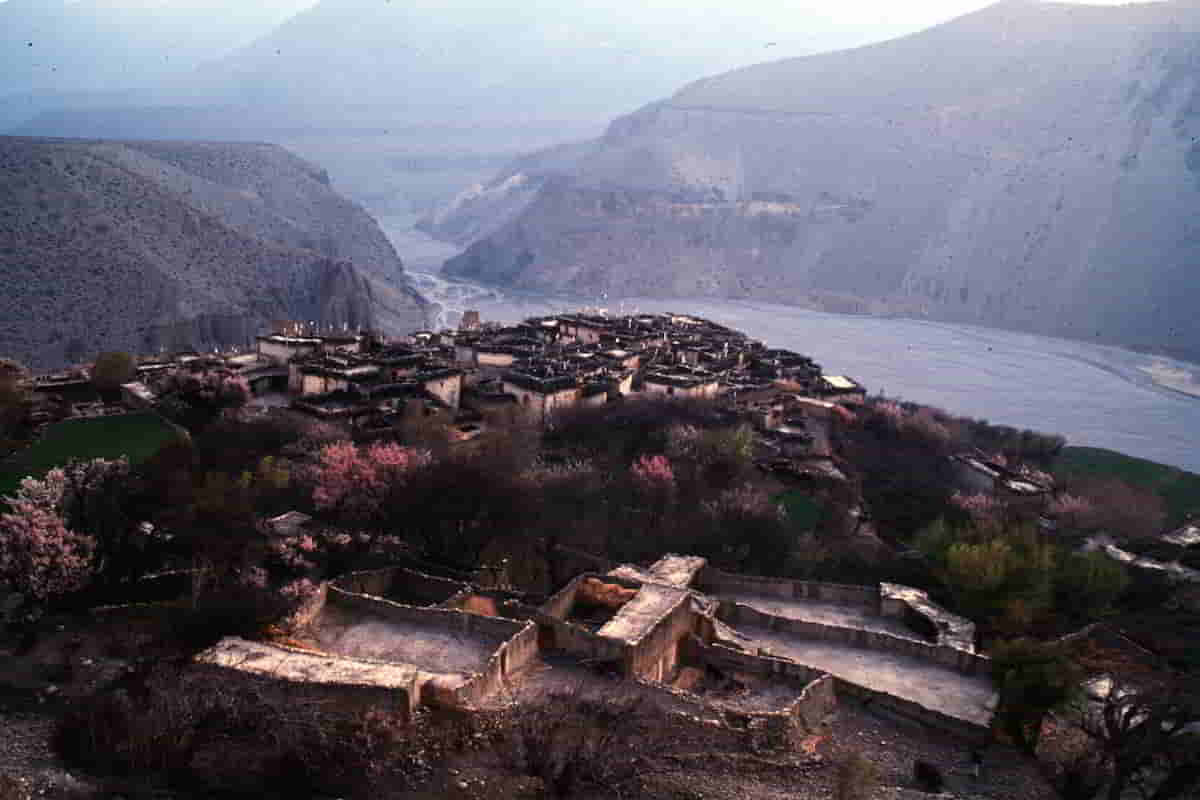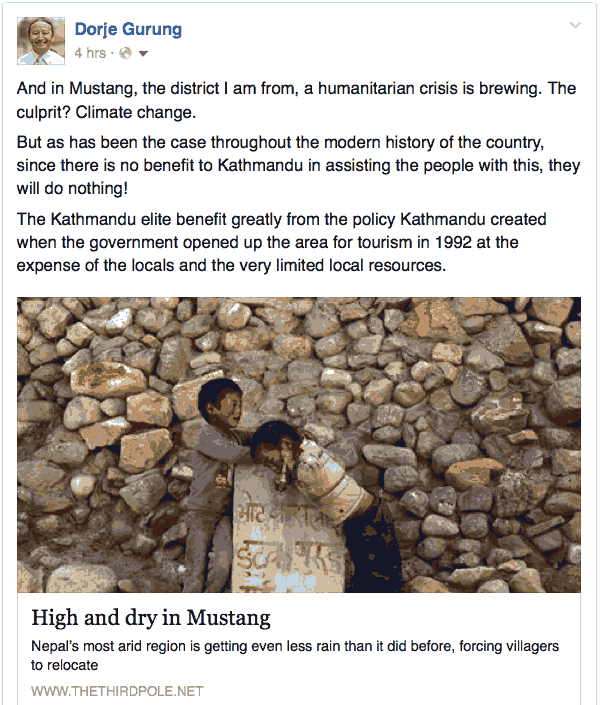
An article I came across earlier today, describing the plight of the people of Mustang district, the district I am from, prompted me to post the following on my Facebook timeline.
 Way back in 1996-97, when I was working at the Red Cross Nordic UWC, I gave a presentation on development and tourism in Mustang. Reproduced below is the introductory part of the presentation which is relevant as background to my Facebook post above.
Way back in 1996-97, when I was working at the Red Cross Nordic UWC, I gave a presentation on development and tourism in Mustang. Reproduced below is the introductory part of the presentation which is relevant as background to my Facebook post above.
Most of the presentation was based on a couple of visits I had made to my village and the surrounding areas. To keep this post short, I have NOT included the details of the effects of tourism and “development”.
* * * * * * * *
Mustang in the last half century.
| 1950 | King of Mustang loses all power to Shah dynasty. Nepal opens its doors to the outside world. |
| 1959 | China annexes Tibet; refugees cross over the border to Nepal. |
| 1960 | Mustang sees the establishment of Tibetan guerrilla base on its soil. CIA and Taiwan train (in Colorado) and arm close to 6000 Tibetan rebels, the Khampas. In a desperate bid to appease China, the Nepali government declares Mustang restricted and censors news of guerrilla activities. No outsiders are allowed except a couple: Michel Paissel in 1964 (who wrote the book Mustang, The Forbidden Kingdom) and Christoph von Furrer-Haimendorf in the 70’s. |
| Early 1970’s | CIA halts Khampa rebel support, and goes on to officially recognize People’s Republic of China. Subsequently, Chinese-government pressure forces the Nepali government on a campaign to crush the rebels. One of the groups surrenders, while the other is ambushed and all members are killed. |
| Mid 1970’s | The government moves into Mustang with grand plans for schools, health posts, police station, development projects, and water taps — in short to ‘develop’ the region. Lower part of Mustang is even opened for tourism, and Annapurna Conservation Area Project is charged with the responsibility of overseeing the maintenance and development of the area. |
In 1990, after the fall of the old government, the newly elected democratic government, seeking to increase the foreign exchange turnover, debates within, and consults with influential members of Kathmandu elite: the environmentalists, developmental workers, academicians, prominent figures in the tourism ‘industry’ and other experts — but NOT the locals — about opening upper Mustang too for outsiders.
The following sentiments expressed by the head of one of the largest travel agencies in Nepal, as detailed by Manjushree Thapa in her book Mustang Bhot in Fragments must have been typical of those involved in the debate.
He said that the threat of environmental degradation necessitated controlled tourism. He also stressed the need to preserve the pristine Tibetan culture of Mustang.
The man had, years earlier, submitted a proposal to the Panchayat government [the King’s rubber-stamp government before 1990], requesting that his organization be allowed to conduct high-cost, low scale specialty tours in the restricted area. Among other things, he had proposed that the three houses of the Raja [i.e. the King] of Mustang be turned into museums, and that other picturesque houses be used to educate travelers about the natural and cultural heritage of the region. His plan would minimize the adverse effects of tourism while maximizing the economic gain.
How would the local people benefit? They could get jobs at the hotels, or become porters. Eventually, they might even become rich enough to open shops and businesses.
” ‘The local people should improve the quality of their lives,’ the man said. ‘But let them not wear ties.’ ”
-Manjushree Thapa, Mustang Bhot in Fragments
And so the opening of upper Mustang was to be another case of top-down imposition, merely an exercise of self-righteousness masked with a thin veil of good intention and altruism.
What’s more, these impositions from the central government and the influential elite in Kathmandu notwithstanding, the region found yet other encroachers — foreign donors and tourists.
| Oct. 1991 | The government announces that Upper Mustang (with 12 other restricted areas along the Nepal Tibet border) will no longer be off limits to foreigners, but grapples to introduce measures and stipulations that would minimize the negative effects of tourism. |
| June 1992 | Finally, the government announces that 200 would be allowed in organized groups. |
Trekking permits were issued at a price of US $500/week. (Other areas in Nepal cost US $20/day.) Since then Mustang has been a hot spot for trekkers. The summer of 1993 I saw a program on Nepal TV about the district which stated that at times, in some settlements, “there are more outsiders then locals.” I wasn’t surprised.
I found Mustang featured in travel magazines and newspapers — in the US and Italy. They all talked about the pristine environment, the undefiled Tibetan culture etc. etc. etc.
Books started popping up like pop corn in a microwave oven. Books in German, French, and English. Among them, the author of the bestseller The Snow Leopard, Peter Matthiasson, in his book, talked about a “hidden valley” that he refused to divulge the location of believing that that would lead to its degradation. (And mentioning it in a book will, I guess, do wonders to preserve it.)
A Dutch film-maker and an Italian writer together came out with a book about the district, plus a movie about a venerable Lama part of which, Norbu and Phuntsho [students at the RCN UWC] tell me, is set in Mustang.
Currently [1996-97] the fee stands at US $700/week. Everything involving trekking in upper Mustang is planned and organized in Kathmandu by an outfitter in Kathmandu as per the stipulation that only organized groups be allowed.
Annapurna Conservation Area Project’s literature states that 60% of the trekking fee is set aside and used for the development of Mustang but there is little evidence to support that. [In the years since then too, I have seen little evidence to support that.] The fee, after all, is paid in the hands of bureaucrats in Kathmandu.
And Mustang is a long, long way from Kathmandu!
Mustang Tibetans were thus turned into tourism products by the powers-that-be seated in Kathmandu. The tourists that visited the area, I found, treated the locals no better. They would suffer all the consequences of visitors many of whom — both Nepalese and foreigners — are often inconsiderate, disrespectful, and ignorant of their ways. But the locals would not be given the opportunity to reap any benefit. They and their very lives would be on display; they would be marketed as live artifacts in the museum of highland desert, Mustang…and would be treated as such or worse.
* * * * * * * *
Since I made that presentation, I have visited Mustang and my village a few times.
Has the government done anything since then? Nop!
Do we expect or hold out hope for the government to do anything? Nop.
The Al Jazeera documentary, Mustang: A Kingdom on the Edge, made only about four years ago, summarizes the many forces — one of which is environmental force — shaping the lives of the people in, and the world of, Mustang. One of its predictions is what the article High and Dry in Mustang is about.
Is it any wonder then that those of us from Mustang have gone about our lives and have tried to do what we can ourselves, instead of waiting for, or going to, the government for help?!
Is it any wonder then that the same people in Kathmandu are treating the Madhesis (southern plains people) the way they are now?!
* * * * * * * *
References
Avedon, John. In Exile from the Land of Snows: The Definitive Account of the Dalai Lama and Tibet Since the Chinese Conquest. The details above about the CIA and Taiwan’s involvement in the Tibetan’s freedom fight came from this book.
Paissel, Michel. Mustang, The Forbidden Kingdom: Exploring a Lost Himalayan Land.
Thapa, Manushree. Mustang Bhot in Fragments.
High and dry in Mustang. “Nepal’s most arid region is getting even less rain than it did before, forcing villagers to relocate.”
Mustang: A Kingdom on the Edge. An Al Jazeera documentary that very neatly summarizes the many forces — one of which is environmental — shaping the lives of the people in, and the world of, Mustang. It was made more than four years ago. Kathmandu didn’t do anything, and isn’t doing anything, of course!
The country is yours. Op-ed by Deepak Thapa about the plight of Tamangs and the arrogance and bigotry of current high-caste government officials.
Police brutality in the Himalaya. Published in August 2017, the article talks about how those in the security apparatus of the country — the armed police — denigrate another group of highlanders in the country. ‘The police repeatedly shouted derogatory and provocative comment at locals: “Saaley bhote haaru lai ek ek gari maar din chu, we will kill you Bhotes one by one.” Bhote is a pejorative [term] used against the highlanders, suggesting that they are Tibetans, and therefore not Nepali.’ [Added on May 30, 2018.]
Cars didn’t carry people, people carried cars. Published in 2015, the article describes how the first cars in the Kathmandu valley were brought here and who brought them. [Added on May 15, 2020.]

Nice article, I enjoyed the historical part.
Hugh